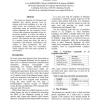Free Online Productivity Tools
i2Speak
i2Symbol
i2OCR
iTex2Img
iWeb2Print
iWeb2Shot
i2Type
iPdf2Split
iPdf2Merge
i2Bopomofo
i2Arabic
i2Style
i2Image
i2PDF
iLatex2Rtf
Sci2ools
ACL
1998
1998
A Simple Hybrid Aligner for Generating Lexical Correspondences in Parallel Texts
We present an algorithm for bilingual word alignment that extends previous work by treating multi-word candidates on a par with single words, and combining some simple assumptions about the translation process to capture alignments for low frequency words. As most other alignment algorithms it uses cooccurrence statistics as a basis, but differs in the assumptions it makes about the translation process. The algorithm has been implemented in a modular system that allows the user to experiment with different combinations and variants of these assumptions. We give performance results from two evaluations, which compare well with results reported in the literature.
| Added | 01 Nov 2010 |
| Updated | 01 Nov 2010 |
| Type | Conference |
| Year | 1998 |
| Where | ACL |
| Authors | Lars Ahrenberg, Mikael Andersson, Magnus Merkel |
Comments (0)

